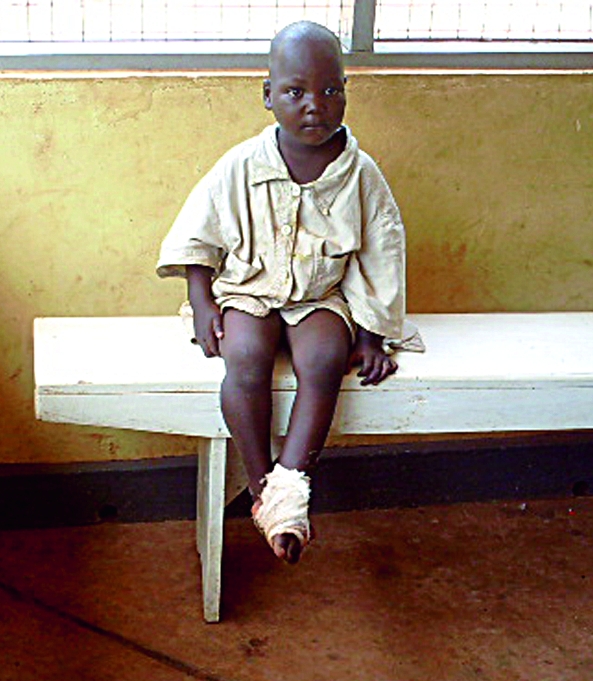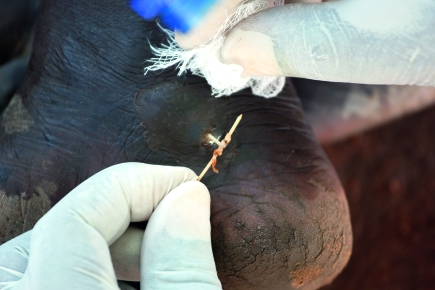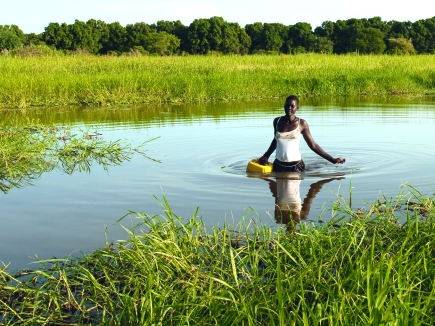Abstract
Ghana could be one of the next African countries to say goodbye to guinea worm. Mawusi Afele reports from Tamale.
Amamata Sumani is on the front line in the war against guinea-worm disease (dracunculiasis) in Ghana – a front line that shrinks every year as the parasitic nematode retreats into its last remaining strongholds in the north of the country. Dracunculiasis transmission can be interrupted at two places in the parasites’ life-cycle – by preventing people with open sores from contaminating water sources, and by filtering drinking water.
“People’s behaviour is part of the problem,” explains Sumani, district director of health services for Central Gonja, in the Northern Region. Gonja has vast tracts of arable land traversed by migrant farmers. “When measures were put into place to control the farmers, they refused to filter their water and waded through dams and ponds with open sores,” says Sumani. Some refuse to filter water because they are too busy trying to make a living; some forget their filter nets; others believe that witchcraft – rather than contaminated water – causes the disease. These reasons are why the Northern Region accounted for slightly more than half of the 229 cases reported in Ghana in the first six months of 2009.
Since the drinking of infected water and release of larvae from guinea-worm sores are key phases of the parasite’s transmission cycle, the migrant farmers are inadvertently assisting the spread of guinea worm. The situation is frustrating because humans are the only known reservoir for the parasite, and denying the worm access to water is a matter of changing human behaviour.
Sumani is attempting to bring about change by calling on chiefs to impose sanctions, focusing on those who refuse to bandage their wounds or who wade through dams and ponds at the risk of polluting the water.
Sumani and her team have also made use of dramatic role play to educate people about the dangers of the disease. Getting people to change their behaviour is not easy, as can be attested by Joseph Yakubu in Kpanvo, a community of some 500 people, also located in the Northern Region.
A teacher by profession, Yakubu has for the past 15 years been a volunteer for the Ghana Guinea Worm Eradication Programme, and one of the biggest obstacles he has had to overcome is the entrenched belief that attributes guinea-worm disease to the will of the gods or witchcraft. “It took some time before I was able to erase these gods, curses and superstitions from their minds,” Yakubu says. Like Sumani, Yakubu has enlisted the help of chiefs and elders to educate the community.
The approach is working. “Kpanvo used to be one of the worst affected villages, but this year it has yet to report a case,” says Yakubu. Attitudes are changing all over the country, including among the migrant farmers of Central Gonja. People are filtering water and staying out of reservoirs. At least most people are, but there is still one group that is not getting the message: young boys. Boys like four-year-old Mohammed Tahidu. He was brought from Gunsi to the guinea-worm containment centre in Tamale, the capital of the Northern Region, after he was diagnosed with the disease.
“These boys hang around all sorts of places and swim in ponds that their parents are not even aware of,” says Jim Niquette, the Carter Center Resident Technical Adviser in Ghana. The Carter Center is an international nongovernmental organization that was founded in 1982 by former US President Jimmy Carter and his wife Rosalynn Carter, and this centre has been at the forefront of the campaign to eradicate guinea worm worldwide.
Niquette and the guinea-worm team are encouraging communities to find out where these children have been swimming or playing and then treat the water with chemicals that kill the intermediate hosts of guinea worm. The disease is caused by drinking water containing water fleas that have ingested dracunculus larvae. This is why filtering the water to remove the water fleas is important. In the human body, the larvae are released and develop into adult worms. The worms eventually emerge through the skin, usually at the feet. If they come into contact with water as they are emerging, the female worms discharge their larvae, setting in motion a new life-cycle.
Locating and treating infected water has become a core element of the National Programme’s campaign, which is also focused on improving water supplies. “This year alone, the Carter Center has fixed 125 water pumps, although this was not part of our original job description,” Niquette says, adding that the work is essential because it is when water supplies break down that people go back to unsafe drinking sources.
All the evidence suggests that the efforts of the programme are paying off. Despite trouble spots like Fufulso-Junction, Ghana seems to have the disease on the run, having posted an 85% reduction in cases from 3358 in 2007 to 501 in 2008. “This is the biggest percentage reduction in cases for a one-year period in any country with over 1000 cases since the programme started,” says Andrew Seidu Korkor, national programme manager, adding that the number of villages that reported the disease has also dropped significantly. Meanwhile, reported cases for the first six months of this year fell to 229 from 416 for the same period last year. The disease is now limited to the Northern Region, and the hope is that once this area is cleared Ghana will be free of the disease.
Like Niquette, Korkor believes clean water is crucial to continued improvement and stresses the National Programme’s commitment in this area. “There was an overall improvement from the proportion of endemic villages with at least one safe water source increasing from 45% at the end of 2008 to 63% during the first half of this year,” he says. “The emergency response system for water was implemented and a rapid response team from the secretariat is in place to access and promptly repair broken-down boreholes.”
But groundwater is not always available. The United Nations Children’s Fund (UNICEF) drilled three such boreholes earlier this year for the Fufulso-Junction community but all were dry. Now a water filtration plant has been brought in to treat the surface water to the great satisfaction of Sumani, who is also pleased to report that guards are now policing the dams in the district. “These measures are working,” she says, “and so far this year almost all cases have been contained.”
And what of the rest of Africa, the only continent now where guinea worm is still endemic? Efforts are concentrated on six remaining endemic countries. Niger and Nigeria reported the last cases in 2008. Ethiopia, Ghana and Mali look ready to interrupt transmission soon, with Sudan likely to be the last to cut transmission.
“Some people confuse breaking transmission with eradication,” says Korkor. “Eradication can be declared only after at least three years of zero case reporting, after having broken transmission, and when other conditions have been satisfied.”
In 2004, governments pledged to interrupt transmission of guinea worm by the end of 2009. That goal may not be achieved, but it is not far off. The only disease to be eradicated by human effort to date is smallpox in 1979. Polio eradication seems tantalizingly close in the last endemic countries: Afghanistan, India, Nigeria and Pakistan.
“We are on the brink of winning the battle against guinea-worm disease,” says Gautam Biswas, programme manager of WHO’s enhanced guinea-worm eradication programme. “In principle, interruption of transmission of guinea worm could be achieved within one transmission cycle,” he says, explaining that it is “largely feasible” to interrupt transmission of guinea worm by the end of 2009 outside Sudan.
Sudan has faced problems in the past due to the conflict and the guinea-worm eradication programme in southern Sudan has only been fully operative since 2006. That said, Biswas is cautious about declaring victory quite yet for Ghana or any of the other countries, pointing out that laxity in surveillance or case containment and mobile populations could still thwart their efforts.
“We’re working very hard to make one last effort,” says Korkor. “We believe we can interrupt the transmission of this disease in the coming year.” ■
A health worker rolls out an emerging guinea worm.
WHO/Gautam Biswas
Stagnant bodies of water are a source of transmission for guinea worm.
WHO/Gautam Biswas

Four-year old Mohammed Tahiru is recovering from a guinea-worm infection.
WHO/Mawusi Afele




